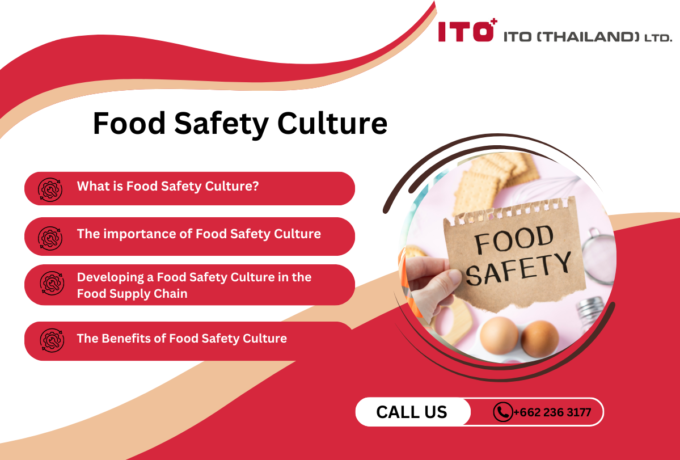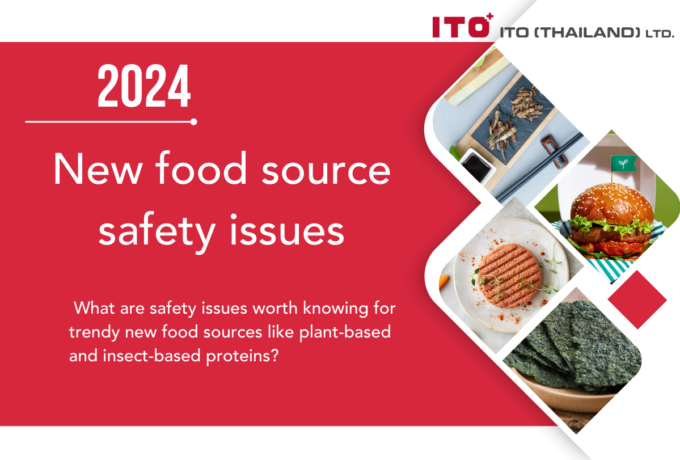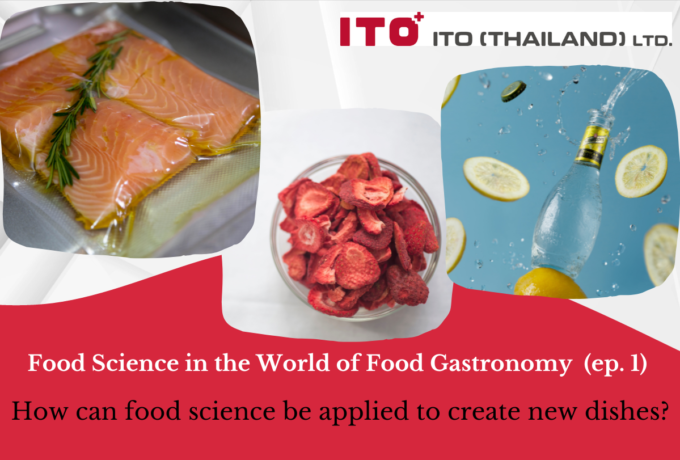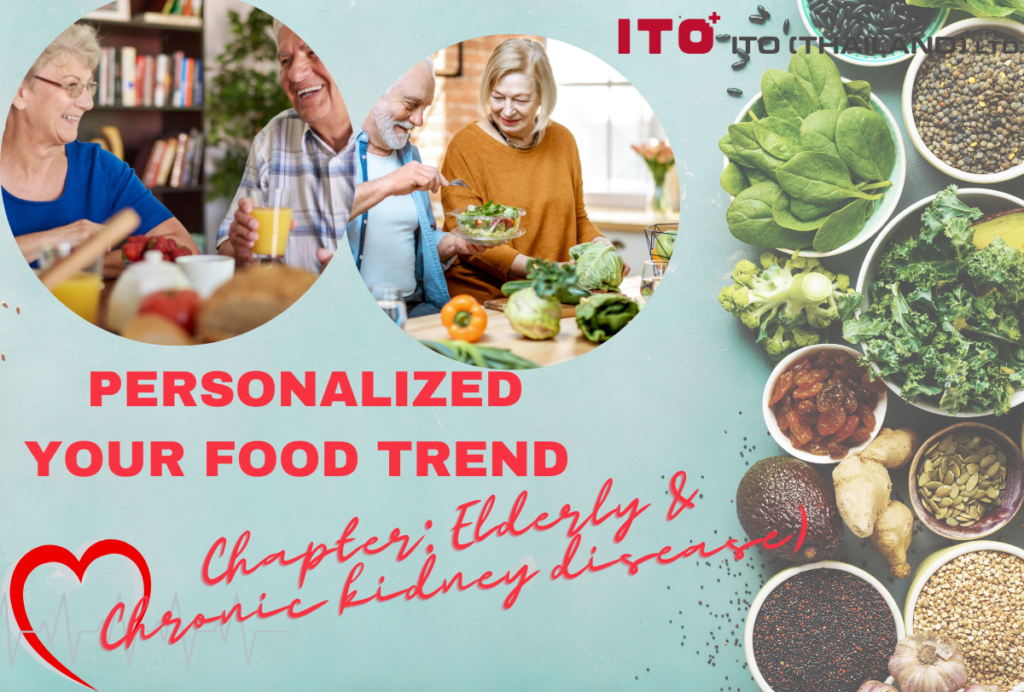ITO Thailand Hygiene Blog
Personalized food trend (chapter: Elderly & Chronic kidney disease)
Personalized food trend (chapter: Elderly & Chronic kidney disease)
Keep up with trend changes in the food industry. Production for the masses is becoming obsolete. And what is the personalized food? Let’s learn about it here.
The change of the competition in the food industry
Nowadays, the food industry world is developing, and the competition is intensifying. The focus used to be on mass production at the industrial scale then it moved to the competition in cleanliness and safety and product quality respectively in pace with the technology developed in each era. However, at present and in the future, just safe and good quality food may no longer be enough. As consumers have more access to information, manufacturers are more competitive. Therefore, new trends emerge, such as premium food trends (premiumization) to add value to products such as using raw materials of a special grade or from specific production sources, emphasis on sustainability, design, appearance, packaging, or consumption methods to create a special experience, as well as the ingredients, increased nutritional values or health functions. The consequence is that the consumers change their purchasing behavior by considering food that has their desired functions, such as food for beauty, to build muscle to strengthen the immune system, to strengthen the digestive system, or to nourish the bones, etc. There is also a demand among patients who have to control their diet due to abnormalities of the body or food allergies. This prompted the emergence of new food alternatives such as alternative proteins, alternative carbohydrates. This ultimately became a food trend for those with specific needs and a personalized/tailor-made food trend.
The design to create personalized food
The design of personalized food differs according to the demands of those need it. The design ranges from improving the formulation by adding functional substances (such as vitamins, antioxidants, plant extracts, prebiotics, postbiotics, etc.), formulating to suit specific consumer groups, improving the texture for chewing and swallowing, improving the appearance (e.g. using a multi-dimensional printer) as well as designing the desired release time (e.g. the encapsulation technology).
Today, we would like to give an example of a group of foods to which researchers have been paying attention and trying to develop new products due to the high necessity and demand.
Food for the elderly
Nowadays, both nationally and globally, we are entering an aging society. This means that the elderly is in a greater proportion in the society. The problem of eating food for the elderly is that they often do not get enough nutrients due to many reasons, such as the deterioration of the taste buds causing loss of appetite, reduced saliva production in the oral cavity, loss of teeth for chewing, problems using the muscles inside the oral cavity to swallow food as well as the ability to digest and absorb nutrients. These result in many elderly people to receive insufficient nutrients.
Food design for the elderly may be done in the form of formula design that provides nutrients and energy for the elderly to be eaten as meal replacements or as a supplement to meals. The liquid form is often preferred because it is easy to eat. In addition, technology may be used to improve the texture of solid foods to make them softer and easier to chew [e.g., using pressure, enzymes, heat, pulse electric fields, and structural destruction by the freeze-thaw (1) method. A combination of techniques can be used for more efficiency, such as adding enzymes to soften vegetables using vacuum impregnation techniques applying the pressure difference principle to push the enzymes deeper (2) into the vegetable slices, etc. In the case of liquid food or beverages, the viscosity of the liquid may be optimized to reduce the risk of swallowing and choking problems. For example, adding hydrocolloids to increase the viscosity and the water holding capacity of the product. The American Dietetic Association has recommended that the minimum viscosity level suitable for people with swallowing problems is 51 cP(3) .
Food for chronic kidney disease patients
There are more and more chronic patients in Thailand. From the patient report from hospitals under the Ministry of Public Health in 2021, it was found that there were 1,007,251 patients with stage 1-5 chronic kidney disease. The fatality trend is also rising, as the death rate was 14.24 per hundred thousand people in 2016, but it was 16.49 per hundred thousand people in 2020 (4).
As the kidneys are responsible for excreting excess waste and minerals from the body, when they are deteriorating, dietary control is required to reduce the workload on the kidneys and the risk of other health problems that follow if the kidneys are not effective in eliminating waste and there is more waste accumulated in the body.
Minerals
Patients with kidney disease should limit their intake of sodium, phosphorus, and potassium. This is why, at present, there is a development of condiment products that reduce the amount of these minerals, such as low sodium condiments, etc., as well as recipes that contain less salt or other minerals in place of sodium to also meet this need.
Protein
The kidneys normally excrete waste from protein in the form of urea. If the kidneys are less efficient, it will be more difficult to eliminate urea. Therefore, kidney disease patients need to control the amount of their daily protein intake.
When more urea accumulates in the intestine, it will stimulate some microorganisms that are pro-urea to produce uremic toxins, causing inflammation. Currently, research has been initiated to study probiotics (beneficial microorganisms) to help reduce the microorganisms that cause these symptoms.(5)
Fat
In relatively critical patients, the body often does not get enough energy since protein intake must be limited. Therefore, in food formulated for patients, the amount of fat (the good ones) is often increased as a source of energy for the body.
References
1.Ueland, Ø., Altintzoglou, T., Kirkhus, B., Lindberg, D., Rognså, G. H., Rosnes, J. T., … & Varela, P. (2020). Perspectives on personalised food. Trends in Food Science & Technology, 102, 169-177.
2.Hernández, S., Gallego, M., Verdú, S., Barat, J. M., Talens, P., & Grau, R. (2022). Physicochemical Characterization of Texture-Modified Pumpkin by Vacuum Enzyme Impregnation: Textural, Chemical, and Image Analysis. Food and Bioprocess Technology, 1-13.
3.Fernandes, J. M., Araújo, J. F., Vieira, J. M., Pinheiro, A. C., & Vicente, A. A. (2021). Tackling older adults’ malnutrition through the development of tailored food products. Trends in Food Science & Technology, 115, 55-73.
4.กมลทิพย์ วิจิตรสุนทรกุล. ระบาดวิทยาและการทบทวนมาตรการป้องกันโรคไตเรื้อรัง. ออนไลน์: https://ddc.moph.go.th/uploads/publish/1308820220905025852.pdf
5.De Mauri, A., Carrera, D., Bagnati, M., Rolla, R., Chiarinotti, D., Mogna, L., … & Del Piano, M. (2020). Probiotics-addicted low-protein diet for microbiota modulation in patients with advanced chronic kidney disease (ProLowCKD): A protocol of placebo-controlled randomized trial. Journal of Functional Foods, 74, 104133.
Related Post
-

Food Safety Culture
Food safety culture plays a crucial role in safeguarding the company's reputation, ensuring the well-being of its employees, and providing a safe experience for its customers.
-

New food source safety issues
What are safety issues worth knowing for trendy new food sources like plant-based and insect-based proteins?
-

British Retail Consortium (BRC) Standard
Food safety management systems play a vital role in ensuring the production and distribution of safe and high-quality food products to consumers. With the global food supply chain becoming increasingly complex, food businesses must implement effective systems prioritising safety, quality, and compliance with industry standards. A food safety management system encompasses a set of procedures, processes, and controls designed to identify, prevent, and manage potential hazards at every stage of the food production and supply process. This proactive approach not only safeguards consumers' health but also protects the reputation and credibility of food companies in an ever more competitive market.
-

Food Science in the World of Food Gastronomy (Part 1)
How can food science be applied to create new dishes?
-

FSSC 22000
Food manufacturers must ensure food safety standards and processes. FSSC 22000 is an official certification program for Food Safety Management Systems (FSMS) recognised by the Global Food Safety Initiative (GFSI). This certification scheme offers a set of guidelines and procedures to ensure uniformity, openness, and safety across your entire supply chain. It applies to all companies operating within the food and beverage industry, ranging from farmers to retailers. By fulfilling the necessary criteria and obtaining FSSC 22000 certification, it is demonstrated that the required standards for food quality and implementing effective processes to manage and mitigate risks associated with food fraud, foodborne illnesses, expensive recalls, and other external threats are met.
-

Food Safety Aspects of Artificial Sweeteners
Artificial sweeteners, also known as sugar substitutes, non-nutritive sweeteners, or high-intensity sweeteners, are artificially produced compounds utilised in place of sucrose (table sugar) to add sweetness to food and drinks. Due to their significantly higher sweetness than regular sugar, only a fraction of artificial sweeteners (200 to 20,000 times less) is required to achieve an equivalent level of sweetness. Since the caloric contribution of these sweeteners, when used in such small quantities, is insignificant, they are often referred to as non-nutritive (4).










